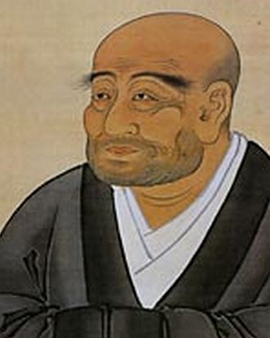Kanō Sanraku (1559 - September 30, 1635) was a Japanese painter of remarkable talent and versatility. Known by a variety of names including Kimura Heizō, Shūri, Mitsuyori and, of course, Sanraku, he excelled in works that combined the powerful elements of the Momoyama style with a calm and realistic depiction of nature. In addition, there was a sophisticated use of color that was characteristic of the Edo period. Sanraku was born in Shiga Prefecture, the son of the painter Kimura Nagamitsu, whose heyday was around 1570. Sanraku spent his life and created his art in Kyoto, where he eventually died.
In the 1570s, Sanraku served as a page for Toyotomi Hideyoshi, who was known as the "second unifier of Japan." During this time, Hideyoshi recognized young Sanraku's extraordinary talent and introduced him to the then principal of the prestigious Kano School of Artists, Kano Eitoku. Eitoku was so impressed with the young man's abilities that he adopted Sanraku and formally accepted him into the Kanō School. Sanraku took over as head of the Kanō School after Eitoku's death in 1590 and continued his work for the Toyotomi clan, continuing to accept commissions from Hideyoshi and his son Toyotomi Hideyori. During this time, the Toyotomi clan focused on restoring Kyoto to its former state of splendor before the Genpei Wars. This included commissions for the Momoyama family castle, restoration of imperial paintings, and paintings for Buddhist temples and Shinto shrines throughout Kyoto.
In 1615, the Tokugawa clan, particularly Tokugawa Ieyasu, consolidated its rule over the Toyotomi clan in the Siege of Osaka. This led to major upheavals in Sanraku's life and career. The death of his chief patron, the burning of his works at Momoyama Castle, and the political upheavals led Sanraku to withdraw from Kyoto's artistic and social circles and accept the tonsure, changing his name from Mitsuyori to the priestly Sanraku.
Sanraku is recognized as one of the most talented artists of the Kanō school. He continued the dramatic style of his mentor Eitoku, but turned slightly away from dynamic imagery, replacing it first with a naturalism of expression and then with a quality of elegant ornamentation. He mastered a variety of painting styles, from large works for decorating castles to smaller monochrome kara-e inspired by Chinese ink painting. Another important contribution of Sanraku to the Kanō school and to Japanese painting in general was his ability to create a true fusion of kara-e and yamato-e. This ability enabled him to bring the Kanō school in line with the second phase of painting during the Edo period, which represented a more intellectual approach to pictorial content by the artist - and often the commissioner.
Sanraku's work was so influential and admirable that her reproductions, especially in the form of art prints, can now be found in many homes and art collections around the world. These art prints allow art lovers to admire the beauty and mastery of Sanraku's work, and help keep his legacy and contribution to Japanese art alive. In addition, they offer insight into the artistic identity of the Japanese as it was reshaped after the turmoil of the Middle Ages, and the role that Sanraku and the Kanō School played in this reshaping.
×





.jpg)
.jpg)
.jpg)
.jpg)
.jpg)
.jpg)
.jpg)
.jpg)
.jpg)
.jpg)
.jpg)
.jpg)
_-_(MeisterDrucke-1454943).jpg)
_-_(MeisterDrucke-1454943).jpg)
.jpg)
.jpg)
_-_First_third_of_17th_cen_-_Waterco_-_(MeisterDrucke-939264).jpg)
_-_First_third_of_17th_cen_-_Waterco_-_(MeisterDrucke-939264).jpg)
.jpg)
.jpg)
.jpg)
.jpg)
.jpg)
.jpg)
.jpg)
.jpg)
.jpg)
.jpg)
_-_(MeisterDrucke-1453898).jpg)
_-_(MeisterDrucke-1453898).jpg)
.jpg)
.jpg)
.jpg)
.jpg)






